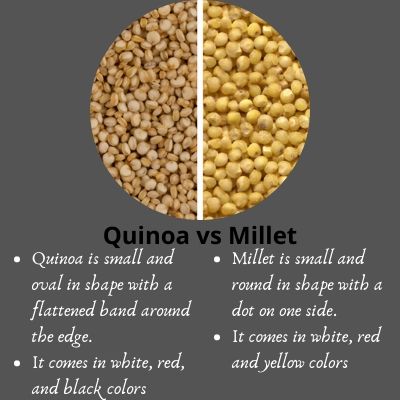Millet is one of the world’s healthiest foods that serve as both human and animal feed. It comes in several varieties with the most popular ones being pearl, foxtail, finger, and proso millet. Millet is cultivated more widely in Asia and Africa.
Quinoa is a seed from the flowering plants of the Amaranth family. Its seeds are gluten-free, which is why it is the recommended replacement for rice for people who have gluten intolerance.
They are both easy to prepare and can easily be incorporated in several dishes from salads to main dishes.
By analyzing the nutritional value and health benefits of each of the plants, you will understand why you need both, and not one of these amazing cereals in your pantry.

The differences between millet and quinoa
Millet is an ancient grain that serves as both human and animal feed. There are several varieties of millet in the family, but the most popular ones are pearl, foxtail, finger, and proso millet.
While pearl millet is the most commonly used for human consumption, the other varieties still carry the same nutritional value.
Quinoa, on the other hand, is crunchy, and it has a nutty flavor. Its seeds are oval and flat and are used either as a side dish, morning porridge, or flour to thicken sauces.
Quinoa has more nutrients than most grains which are locally marked as superfoods.
Despite the fact that millet and quinoa are similar in several ways from their health benefits to methods of cooking, they also differ in various ways as shown below.
| Quinoa | Millet | |
| Appearances | Small and oval in white, black and red colors | Small and round in Yellow, white, red colors |
| Use | Human feed | Human and animal feed |
| Taste | Slightly nutty and creamy taste with a fluffy texture | Nutty taste |
| Nutrition | Contains all the essential amino acids (complete protein) | Lacks the essential amino acid lysine (lower protein content) |
Essential Amino Acids and Minerals in Millet and Quinoa
Both contain the minerals Manganese, Phosphorus, Copper, Folate, Iron, Magnesium, and Zinc. They provide a higher percentage of amino acids than many of the other cereals referred to as superfoods.
Here is a comparison of the mineral content in both millet and Quinoa.
A cup of boiled millet contains 25 percent of the recommended daily intake of phosphorus. It will also give you 19 percent of the daily value of magnesium that you need, 8 percent of iron, and 6 percent of folate.
Quinoa also contains high amounts of manganese, copper, phosphorus, folate, and magnesium. Additionally, it gives you 0.39 milligrams of vitamin A, Beta carotene, 0.32 units of Vitamin B1-Thiamin, 0.39 Riboflavin-B2, and 16.4 milligrams of Vitamin C-ascorbic acid, and 8.71 grams of Tocopherol or vitamin E.
Health Benefits of Millet and Quinoa
It is also important to compare the health benefits which your body gets from millet and quinoa so as to understand the two super foods better.
- Both Millet and Quinoa are excellent when it comes to controlling blood sugar levels. They are high in fiber content which slows down digestion, reducing the possibility of sugar spikes in the bloodstream. They are therefore an ideal meal for people with type II diabetes.
- They are an excellent source of soluble fiber which lowers fatty acids and triglycerides in the blood by trapping fat hence reducing the levels of cholesterol in the blood.
- Millet and Quinoa are gluten-free in their nature. They are therefore ideal for people who are sensitive to rice, wheat, and other white cereals that contain gluten.
- Both millet and Quinoa have a higher protein content than other cereals of their king. The higher protein levels mean they stay in the digestive system longer, and will be ideal for someone on a weight loss diet.
- A cup of millet or quinoa has lower calories compared to rice, corn, and whole wheat, which means that you will not exceed your recommended daily calorie intake when you include them in your daily diet.
- Quinoa has a very high level of flavonoids and other anti-oxidants. The two main antioxidants found in Quinoa are Quercetin and Kaempferol, which are highly anti-inflammatory and help fight cancer and other age-related health conditions. Millet also contains potent antioxidants which are very effective in protecting the DNA and reducing cellular inflammation.
- Quinoa contains potassium which helps to keep the heart healthy by maintaining a regular heartbeat.
Can You Substitute Millet for Quinoa?
You can substitute millet for quinoa as they both contain similar dietary profiles.
However, there is something that you should note about both foods. They both contain certain traces of compounds known as anti-nutrients.
Millet contains Phytic acid and an anti-nutrient that can potentially block the absorption of all the minerals that you get from food. It specifically interferes with potassium, calcium, iron zinc, and magnesium uptake in the ileum.
Quinoa also contains similar anti-nutrients. These include Phytates and oxalates. Phytates reduce the uptake of iron and zinc in the bloodstream while oxalates can lead to the formation of kidney stones.
The best way to deal with these anti-nutrients is to soak a millet of quinoa before cooking. You can also scrub the seeds of quinoa and millet thoroughly with water before cooking them.
Conclusion
Both Millet and Quinoa are amazing superfoods to add to your diet. They contain a similar dietary profile, which means that you can easily substitute one for the other.
However, for the sake of flavor and variety, it would even be more amazing to have both of them in your pantry. As long as you have both, you are assured that you have an amazing source of almost all of the nutrients your body needs.
Reference
www.ontrackdiabetes.com
